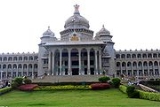
Vidhana Soudha
Overview
Karnataka legislature
The Karnataka Legislative Assembly is the lower house of the bicameral legislature of Karnataka state in southern India. Karnataka is one of the six states in India, where the state legislature is bicameral, comprising two houses...
of Karnataka
Karnataka
Karnataka , the land of the Kannadigas, is a state in South West India. It was created on 1 November 1956, with the passing of the States Reorganisation Act and this day is annually celebrated as Karnataka Rajyotsava...
. It is an imposing building, constructed in a style sometimes described as Neo-Dravidian, and incorporates elements of Indo-Saracenic
Indo-Saracenic Revival architecture
The Indo-Saracenic Revival was an architectural style movement by British architects in the late 19th century in British India...
and Dravidian
Dravidian architecture
Dravidian architecture was a style of architecture that emerged thousands of years ago in Southern part of the Indian subcontinent or South India. They consist primarily of pyramid shaped temples called Koils which are dependent on intricate carved stone in order to create a step design consisting...
styles. The construction was completed in 1956.
Kengal Hanumanthaiah
Kengal Hanumanthaiah
Kengal Hanumanthaiah was the chief minister of the old Mysore State in India from 30 March 1952 to 19 August 1956...
is credited with the conception and construction of the Vidhana Soudha, . The foundation was laid by the then Prime Minister of India
Prime Minister of India
The Prime Minister of India , as addressed to in the Constitution of India — Prime Minister for the Union, is the chief of government, head of the Council of Ministers and the leader of the majority party in parliament...
, Jawaharlal Nehru
Jawaharlal Nehru
Jawaharlal Nehru , often referred to with the epithet of Panditji, was an Indian statesman who became the first Prime Minister of independent India and became noted for his “neutralist” policies in foreign affairs. He was also one of the principal leaders of India’s independence movement in the...
, on July 13, 1951.

